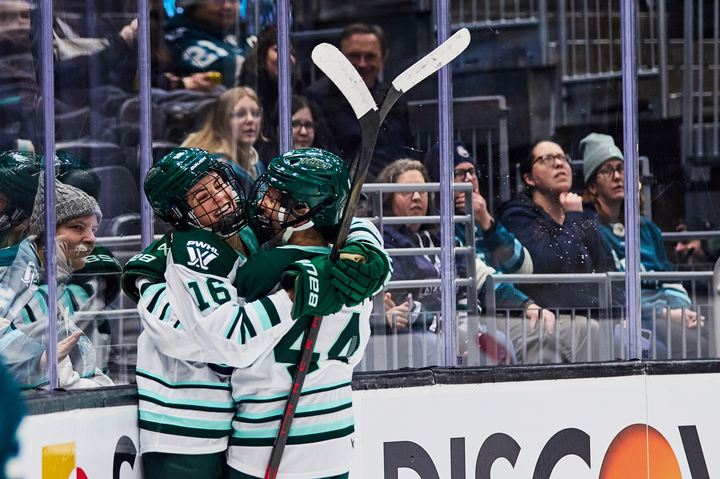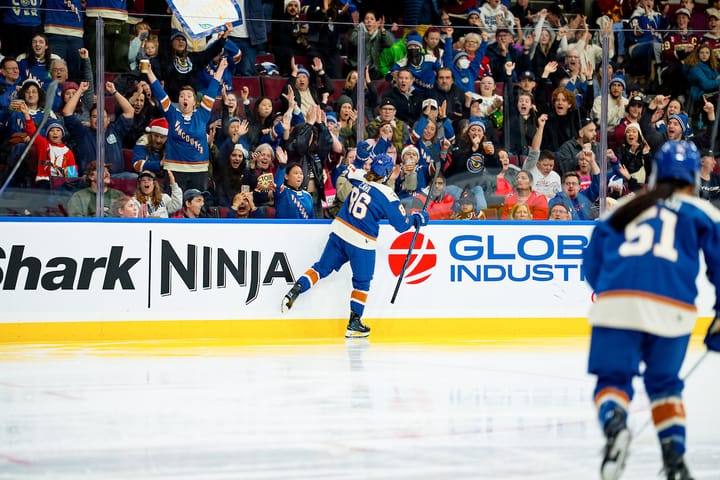The best single season performances in NWHL history
Determining the most dominant seasons in the first four years of the NWHL with average game score
Recently, Hockey-Graphs published my work on an improved NWHL game score. The bulk of my work was built on the foundation established by Shawn Ferris in his initial NWHL game score and Dom Luszczyszyn’s NHL Game Score. I used the same methodology as Shawn and Dom, but introduced primary point data as well as two more years of league-wide data on goals, shots on goal, faceoffs, and penalties.
In testing this improved NWHL game score, I found that it increased repeatability, which meant it was a better tool for predicting player performance. The testing also proved why primary assists are more valuable than secondary assists, especially for predicting performance. This was not a radical breakthrough, but it is still significant to see it proven by the data. To put it simply: primary assists are a big deal.
Skater Game Score = G + (.90*A1) + (.66*A2) + (.10*SOG) + (.11*FOW) – (.11*FOL) – (.15*PENT)
As you might expect, I went through a lot of data to test this updated game score. I wanted to get an idea of what a great average game score looked like over the course of an NWHL regular season. As a result, I was able to produce a list of the best single-season performances in the league’s four-year history measuring by game score per game (GS/GP).
What is Game Score?
Before we go any further, let’s first establish what game score is and what it is trying to do.
Game score is an attempt to have a “one-stat-tells-all” value that helps us judge the performance of an individual player in a single game or over multiple games. Like a lot of stats in the sports world, it started in baseball. Dom Luszczyszyn was the first to bring it over to the world of hockey. Dom used relevant statistics like primary assists, secondary assists, shots on goal, blocks, penalties taken and drawn, faceoff wins and losses, and individual Corsi For and Corsi Against ,and measured their frequency against goals. In doing this he assigned weights to those events.
Player Game Score = (0.75 * G) + (0.7 * A1) + (0.55 * A2) + (0.075 * SOG) + (0.05 * BLK) + (0.15 * PD) – (0.15 * PT) + (0.01 * FOW) – (0.01 * FOL) + (0.05 * CF) – (0.05 * CA) + (0.15 * GF) – (0.15* GA)
When you plug all of those weighted stats into a formula, you get a statistical picture of a player’s performance in a single game. This is what we refer to as game score.
Related
Women’s Hockey Analytics Primer
The Best Season Performances for Skaters to Date
NWHL game score is skewed in favor of centers and offensive defenders because of the dearth of data we have to work with. Primary assists and faceoffs are included in NWHL game score, but blocked shots, Corsi For, Corsi Against, and penalties drawn (for the time being) are not. This is why the table below, which features the 20 highest GS/GP among skaters in league history, features so many centers and so few defenders.
The names that finish at the top of the table above aren’t surprising. Hilary Knight, Brianna Decker, Kelli Stack, Amanda Kessel, and Alex Carpenter have once been or are currently among the most talented forwards to play for Team USA. However, the name at the very top of the list is Kelley Steadman, who played in just two senior Women’s World Championships for the United States.
Steadman was a force of nature in the NWHL’s inaugural season. In 10 games she averaged 11.9 shots per game (SOG/GP), scored 13 goals, and picked up five primary assists. Those look like the numbers you’d get if you played a hockey video game on the easiest difficulty setting or something. Steadman finished that season with a 2.95 GS/GP, the best yet recorded in a single season for a player who appeared in at least five games.
It’s worth noting that Steadman took only 18 faceoffs that season, so her game score didn’t get a bump from winning draws like the best seasons we saw from Decker, Knight, or Stack. In other words, she played primarily on the wing, which makes her 2.95 GS/GP in 2015-16 and Kessel’s 2.16 GS/GP in 2016-17 all the more impressive.
The table above also reveals that nine of the top-10 GS/GP performances in NWHL history occurred in the first two seasons. This is likely due to the fact that the league-wide shooting percentage — 10.1 Sh% and 11.1 Sh%, respectively — and the total shots per-game — 63.8 and 58.9, respectively — were at their highest in those two seasons. A good explanation for this is that the bulk of Team USA’s senior talent pool was in the league at that time.
That number dropped significantly in the third season due to centralization for the Pyeongchang Olympics and rebounded only slightly in the fourth season. Elite players like Knight, Decker, Stack, Steadman, and Carpenter did not play in the NWHL in 2018-19. Team USA’s senior talent was split primarily between the NWHL and the CWHL that season. That, undoubtedly, played a role in things like league-wide shooting percentage and saving percentage as well as how many shots found their way to the net in each game.
The Best Seasons for Goalies to Date
Although I found that we didn’t have enough data to test for game score repeatability with goaltenders, it is still a stat we can work with. With that being said, game score for goalies isn’t yet at a place where we can confidently use it as a one-stat-tells-all, especially if we want to compare performances between skaters and goalies. Instead, we should use a goalie’s game score as a road sign — something that can point us in the right direction.
Goalie Game Score = (.15*SV) – GA
Instead of using GS/GP for goalies, I determined that game score per-60 minutes (GS60) would be a better approach because of the small sample sizes we’re working with for NWHL goalies. After all, the average season to date is less than 18 games long and only three goalies in league history have played more than 900 minutes (in all situations) in a single season.
The table below lists the Top-15 seasons for NWHL goaltenders, as measured by GS60. Note: goalies who appeared in fewer than 240 minutes in a season were excluded for having too small a sample size.
It’s hard to put into words just how exceptional Jaimie Leonoff’s 2015-16 season was. She faced an average of 43.3 shots against per 60 minutes (SA60) and still finished with a .936 save percentage. That is, by far, the heaviest workload among the goalies in our Top-15. The only netminders who are even in the same neighborhood are Nicole Stock and Nana Fujimoto, both of whom also had banner years in the 2015-16 season.
Another season that stands out is Lauren Slebodnick’s 2016-17 campaign where she finished with a 1.76 GS60. However, when we consider Slebodnick’s workload of 21.1 SA60, her average game score definitely loses some of its luster. That doesn’t mean that Slebodnick’s performance for the Boston Pride that season’s wasn’t great. It does, however, serve as an example for why context is so important for stats, especially with goalies.
Thus far, the only goalie to finish on top of the league in GS60 and earn honors as the Best Goaltender of the Year in the same season is Amanda Leveille.
Leveille’s 2017-18 season wasn’t just outstanding because many of the league’s best players were preparing for the 2018 Olympics. She faced an average of over 30 shots per night and set a record for the most minutes played by a goalie in an NWHL season. She was the definition of a workhorse starter for the Buffalo Beauts that year. The fact that she finished with a 1.67 GS60 the next season with the Minnesota Whitecaps solidifies her place as one of the best goalies in the NWHL’s brief history.
All data courtesy of NWHL.zone and the author’s own tracking and research.





Comments ()